To Link
Page To Gunwriters' Index Page To Part 2/2 of Suomi History
MOWING MACHINE OF TIKKAKOSKI:
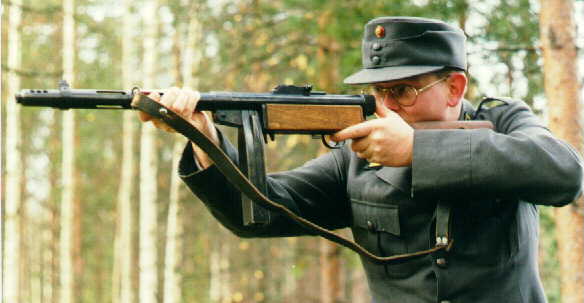 Muzzle brakes or
compensators are useless gimmicks on long-barreled submachine guns like KP/-31. Pressure
of the muzzle blast is too low to generate reaction force strong enough to prevent
"muzzle climb". A skilful submachine gunner can easily control the recoil
and keep the gun steady, by keeping the thumb of his trigger hand behind the breech-cap.
This thumb must receive whole recoil force. The butt of the gun is not allowed to hit or
even touch shoulder of the gunner. Another way to control the recoil is to keep the gun
with stiff hands, again without solid contact on the shoulder.
Muzzle brakes or
compensators are useless gimmicks on long-barreled submachine guns like KP/-31. Pressure
of the muzzle blast is too low to generate reaction force strong enough to prevent
"muzzle climb". A skilful submachine gunner can easily control the recoil
and keep the gun steady, by keeping the thumb of his trigger hand behind the breech-cap.
This thumb must receive whole recoil force. The butt of the gun is not allowed to hit or
even touch shoulder of the gunner. Another way to control the recoil is to keep the gun
with stiff hands, again without solid contact on the shoulder.
Suomi Submachine Gun, KP/-31
Part 1/2
Text: P. T. Kekkonen
Photographs: J. Hartikka
Proofreading: Eero Juhola (See home pages: Finnish Weapons)
The famous Suomi submachine gun or machine carbine was designed to be an
"everlasting" piece of equipment. Broken or worn-out parts like extractors,
barrels, breech-bolts, recoil springs and wooden stocks were easy to replace. Receiver and
jacket were truly durable parts, and - with the exception of some springs and pins - the
small pieces of trigger mechanism did not easily wear out. The very first prototype of the
SUOMI gun was made by a young Finnish Army armorer, AIMO JOHANNES LAHTI (1896-1970) in
1920 or 1921. The caliber was .32 A.C.P. or 7.65 mm Browning. The gun was 30 centimeters
(11.8 inches) long. This "machine pistol" was a very reliable gun but the .32
Auto cartridge was too weak for "serious military use" and the cyclic rate of
fire was presumably too high.
It is not known, whether designer Lahti attempted to remedy this fault of all "rattle
pistols" with some kind of pneumatic firing-rate reducer. Prototype gun and it's
drawings are, unfortunately, lost forever. Next prototype Suomi, in caliber 7.65 x 21 mm
Parabellum or Luger, was made by machine and tool manufacture Engineering Shop Leskinen
& Kari, of Tampere, Finland, in 1922. A single specimen of Konepistooli (machine
pistol) model 1922 survives in a German museum, the Wehrtechnische Studiensammlung in
Koblenz.
The first Finnish patent on submachine gun was applied and granted in 1922. The inventors
were Master Armorer A. Lahti, lieutenant Y.Koskinen and L. Boyer-Spoof, also lieutenant of
Finnish Army and the commanding officer of Aimo J. Lahti.The patent was granted on
September 11, 1922 and covered a new way to attach the barrel, and the trigger mechanism
with a simple selector for semi-automatic shooting. The breech bolt of the early model
M/22 was similar to those of the German Bergmann, the British STEN and the Australian Owen
bolt, but there were some special design features to reduce otherwise excessive cyclic
rate of fire since model M/22. The firing-rate reduction devices were based on air
compression or vacuum behind the breech-bolt, which was almost hermetically fitted to the
tubular receiver.
According to the patent drawings most of the devices were too delicate and difficult to
adjust correctly. The least complicated firing-rate reducer device, a simple vacuum valve,
was used in every Suomi submachine gun since 1930 to ca. 1986, when last examples of this
magnificent piece of equipment were assembled. Designers of "Pre-Suomi", A.
Lahti, Y. Koskinen, L. Boyer-Spoof and their commanding officer captain V. Korpela, formed
a company "Konepistooli Oy" ("Machine Pistol Ltd.") for submachine gun
production.
The company Leskinen & Kari was able to make just a tiny batch of prototype guns (less
than five handmade pieces) but tool-making Shop Tool Oy, in Helsinki, could make all the
necessary equipment for production of machine pistols. A large industry hall was shared
with another machine and toolmaking shop, Leonard Lindelöf Oy, which also made submachine
guns, licensed copies of German Bergmann MP 18-1 from 1923 until 1932. During this time
Lindelöf Oy could assemble only sixty (more or less miserable) copies of the MP 18, while
Tool Oy made more than a hundred guns in the first years of manufacturing, from 1922 to
1925.
The barrels of these "pre-Suomi" models were bought from England. All other
parts, except the Swiss-made recoil springs from the Bergmann MP 18-1, were made in
Finland. Almost all essentials of the Suomi gun were present in Konepistooli Osakeyhtiö's
model KP/-26. The front of the breech-bolt was rebated, or "necked", just like
in Villar-Perosa and Thompson submachine guns, to assure a reliable feed. The cocking knob
was non-reciprocating. Rear end of the receiver was almost hermetically sealed and its end
cap enclosed a screw-adjustable firing rate reduction device which worked by vacuum.
From "pre-Suomi" to KP/-31
An adjustment of the cyclic rate was necessary because of readiness to adopt caliber 7.63
x 25 mm Mauser for export model submachine guns. The length of the breech-bolt stroke was
just a bit more than the overall length of 7.63 mm Mauser or 9 x 25 mm Mauser
"Export" cartridge. The Finnish Army, Frontier Guards and Civil Guard were
satisfied with the less powerful but very accurate 7.65 x 21 mm Parabellum cartridge,
which had been an official pistol caliber of armed forces since 1923.

The magazine of the "pre-Suomi" guns was a curved box, for 36 rounds, going
through a rather narrow magazine-well into the receiver. It was impossible to develop a
well-designed large drum magazine for gun like KP/26. Russians learned this fact the hard
way - the Finns with less difficulty.
The designer Aimo J. Lahti honed his invention to perfection during years 1930 - 1931. His
intention was to sell the manufacturing rights of this Suomi submachine gun to the State
of Finland, but the Finnish government had no manufacturing capacity in state-owned
Valtion Kivääritehdas (VKT. Since 1946 VMT. Since 1950 until 1988 Valmet Oy/ Tourula
Works).
The privately-owned Iron and Wood Industry of Tikkakoski, or since 1929 just Tikkakoski
Oy, bought the manufacturing license of the greatly improved submachine gun, now called as
Suomi-KP Model 1931. The owner of the license for submachine gun manufacture was, of
course, the patentee of several improvements on KP Model -26, which altered the
"pre-Suomi" gun into the real Suomi gun.
The patent application, dated July 4, 1930, covered a "full-automatic firearm with a
blow-back bolt and a vacuum valve in breech-cap". Another patent application, dated
July 5, covered an oblique front face of barrel jacket as compensator of
"jump-effect", and a combined full-auto, semi-auto and safety selector placed
ahead of the trigger. A third patent, also applied for July 5, covered barrel jacket
bayonet-mounting and an improved, positively locking bolt.
A section drawing of the Suomi KP/-31 submachine gun. An original illustration from the booklet "SUOMI-KONEPISTOOLI" by OY TIKKAKOSKI AB (in 1942). Click image to expand for closer look.
Remarkable Innovations
Some unpatented but significant improvements were the adoption of 9 x 19 mm Parabellum or
Luger cartridge and an "open-jaw" magazine well, which allows the use of drum
magazines along with a Swedish pattern double staggered-row magazine or "a coffin
clip", as well as the usual staggered-row clip for 20 rounds.
The new owner of the manufacturing license, Tikkakoski Oy, was actually a multinational
enterprise. The main stockholder was a German called Willi Daugs. The first shots
discharged in anger were fired during the Gran Chaco War between Bolivia and Paraquay in
1932 to 1935. Apparently both belligerents possessed some Suomi submachine guns, either
imported from Finland or captured. South America, the Baltic countries and Poland were
objects of exporting effort before, and Sweden, Bulgaria, Denmark, Germany, Croatia and
Switzerland during World War II. Manufacturing licenses were sold to Denmark, Sweden and
Switzerland.
Lessons for whole World
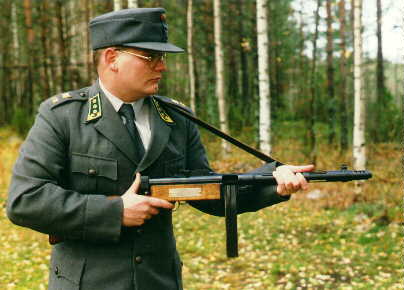 Most Finnish-made guns were, however, bought for use
by the Finnish armed forces. When the Russians tried to incorporate Finland into "the
Big Happy Family of Soviet Nations" in November 1939, there were about four thousand
submachine guns model KP/-31 ready for a hot salutation against unwanted liberators. This
famous Winter War taught whole world to value of submachine guns as true instruments of
warfare, not mere "emergency weapons for defense at close quarters for the personnel
of specialist corps, such as motor transport drivers, spare numbers of machine-gun units,
tank crews and head-quarter details." (Quotation from a British "Textbook of
Automatic Pistols" by Robert Kenneth Wilson, written in 1935).
Most Finnish-made guns were, however, bought for use
by the Finnish armed forces. When the Russians tried to incorporate Finland into "the
Big Happy Family of Soviet Nations" in November 1939, there were about four thousand
submachine guns model KP/-31 ready for a hot salutation against unwanted liberators. This
famous Winter War taught whole world to value of submachine guns as true instruments of
warfare, not mere "emergency weapons for defense at close quarters for the personnel
of specialist corps, such as motor transport drivers, spare numbers of machine-gun units,
tank crews and head-quarter details." (Quotation from a British "Textbook of
Automatic Pistols" by Robert Kenneth Wilson, written in 1935).
Shooting with sling and instinctive aim. Experienced
submachine gunners preferred this method during Finnish wars of 1939 - 1945. This
particular gun is equipped with a quadruple-row "coffin magazine" and has a
silver plaque on the right side. A nice birthday present to a Finnish firearms collector
from a distinguished ranger veteran of the 1941 - 44 war. Shootable? Of course..!
Construction of KP/-31
The words "robust" or "sturdy" capture the essence of the so called
"first generation submachine guns" such as Thompson, Bergmann and Suomi. They
were not yet spot-welded from sheet steel stampings and tubings, along with rough
investment-cast main parts and brittle phenolic plastic components (called by disparaging
name "gutta-percha parts" in Finland). The true Suomi, Konepistooli model 1931,
is entirely made in Finland.
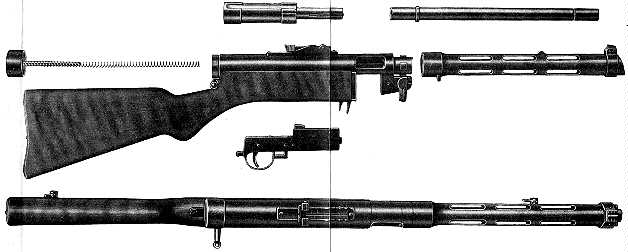
KP/-31 stripped to main parts. Photograph from original illustration of the booklet "SUOMI-KONEPISTOOLI" by OY TIKKAKOSKI AB (in 1942).
The Barrel
Barrels were initially made by Birmingham Small Arms in England but from 1930 onwards by
Tikkakoski Oy, or the Gunsmithing Shop Joonas Matarainen, in Finland. Especially J.
Matarainen drilled, rifled and lapped the bores of submachine guns with same
scrupulousness as those of his famous competition rifles. There were always two barrels
for each KP/-31, both of them selected to shoot with the same adjustment of sights. If one
or other barrel was worn-out by shooting or corroded by lack of proper maintenance, it was
easy to get more spare barrels from factory or depot by order.
If the "sighting-in stamp" in the rear flange of barrel was matched that of the original barrel it was guaranteed that the center of hit-group (ten aimed shots at 100 meters) was within one inch (25 millimeters) of the aim-point, without re-adjustment of sights. Semi-automatic test shooting was conducted by factory test-shooters using just a simple bench rest. All ten shots must hit on the bullseye of the target at one hundred meters. Diameter of the bullseye was 100 millimeters, or less than four inches. Sub-M.O.A. groups weren't uncommon occurrences.
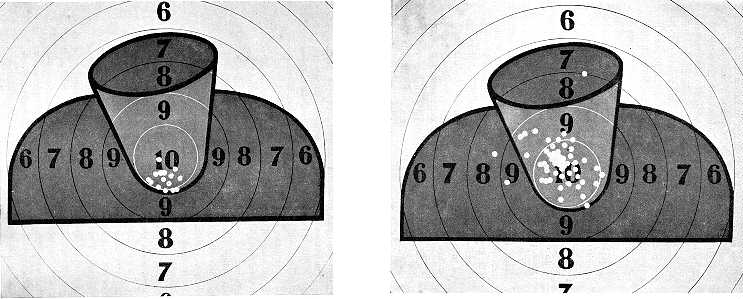
The KP/-31 was the accuracy standard to which other sub-machine guns of the time were compared. Above are two targets shot during official Army weapon acceptance tests from 100 meters' distance. Left target: 15 rounds of semi-auto shots from bench rest. Right target: 50 rounds of full auto shots as a single long burst from bench rest. Photograph from original illustration in the KP/-31 manual "SUOMI-KONEPISTOOLI" by OY TIKKAKOSKI AB (1942).
Milled from solid steel
The receiver is machined from solid steel forging, with accurately bored and honed
thru-going tunnel for the breech-bolt and a concentric, narrower tunnel for the rebated
"neck" of the bolt. The outside diameter of receiver is 37 millimeters and the
diameter of the breech-bolt is 31 millimeters, with practically air-tight fitting into
receiver.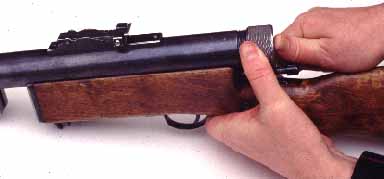 The rear end of the receiver is closed with a screw
cap. Its seven threads are not interrupted, like those of Bergmann MP 18-I or 28-II. When
field stripping and re-assembling the action of KP/-31, it is necessary to wind six to
seven rotations of the cap while keeping the recoil spring compressed by pulling the
cocking knob rearwards . The "hermetic" cap closure was found essential to
assure proper functioning of firing-rate reducer or vacuum valve within the cap.
The rear end of the receiver is closed with a screw
cap. Its seven threads are not interrupted, like those of Bergmann MP 18-I or 28-II. When
field stripping and re-assembling the action of KP/-31, it is necessary to wind six to
seven rotations of the cap while keeping the recoil spring compressed by pulling the
cocking knob rearwards . The "hermetic" cap closure was found essential to
assure proper functioning of firing-rate reducer or vacuum valve within the cap.
Start of field stripping. Pull the cocking knob all the way backwards and while holding it, unwind the breech-cap (seven rotations counter-clockwise). IMPORTANT NOTE: The powerful recoil spring is fully compressed during winding and unwinding breech-cap! Keep your thumb on the center of the cap while rotating it with fingers of another hand.
It is necessary to to remove barrel jacket and barrel for routine maintenance, inspection and bore cleaning. Contrary to Bergmann MP's (to say nothing about Thompson), it is easy to remove even a red-hot barrel and install a cool spare barrel into front end of the receiver; just turn the jacket-key 90 degrees downwards and rotate the jacket 45 degrees to left, then pull the jacket forwards and loosen the barrel, also forwards.
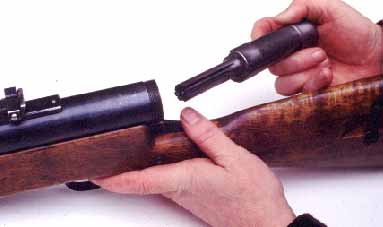 Breech-cap and recoil
spring removed. Note the rebated "bolt neck". KP/-31 is among the most reliable
automatic firearms if the cartridges are faultless, the magazines flawless and the
maintenance of mechanism is done scrupulously - without overdoing. As an example the
inside of the receiver is not be lubricated but washed "bone dry" with gasoline
or kerosene, especially in frosty weather, when the slightest amount of grease or oil may
cause misfire or even a more serious accident. Contrary to a common misconception,
shooting with an unlubricated gun does not cause wear of receiver or moving parts.
Breech-cap and recoil
spring removed. Note the rebated "bolt neck". KP/-31 is among the most reliable
automatic firearms if the cartridges are faultless, the magazines flawless and the
maintenance of mechanism is done scrupulously - without overdoing. As an example the
inside of the receiver is not be lubricated but washed "bone dry" with gasoline
or kerosene, especially in frosty weather, when the slightest amount of grease or oil may
cause misfire or even a more serious accident. Contrary to a common misconception,
shooting with an unlubricated gun does not cause wear of receiver or moving parts.
Q.D. Barrel Was Essential
During the war it was often necessary to cover hand with a mitten or thick cloth before
grasping the hot jacket, and to push the red-hot barrel out with the point of a
puukko-knife. The quickly detachable barrel, bayonet-mounted by four heavy lugs, 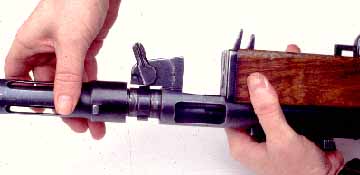 was a rather expensive technical construction but actual fighting
experience often proved it a successful barrel mounting method, compared with the thread
mount of Bergmann or STEN and the fixed barrel of the Thompson. Many Finnish submachine
gunners shot several thousand rounds during an hour or two, mowing down oncoming Russian
hordes during the Winter War and the Finnish Third Independence War of 1941 to 1944.
was a rather expensive technical construction but actual fighting
experience often proved it a successful barrel mounting method, compared with the thread
mount of Bergmann or STEN and the fixed barrel of the Thompson. Many Finnish submachine
gunners shot several thousand rounds during an hour or two, mowing down oncoming Russian
hordes during the Winter War and the Finnish Third Independence War of 1941 to 1944.
Removing a (cool) barrel and jacket is easy, compared with almost any submachine gun (save the OWEN). Turn the jacket latch or key down. Then, turn the jacket counter-clockwise while pulling it forwards. Once the jacket is removed, pull the barrel forwards out from the receiver.
Sometimes a single Finnish submachine gunner against a hundred Russians. At other times
one gunner and a couple of magazine-filling assistants struggled against a full infantry
company - 200 Russians - killing almost half of their troop and wounding many others. Some
Finnish writers of war and remembrance novels say they have given too small numbers of
Killed In Action enemy soldiers in their books because "nobody can believe my
eye-witness' claim that one submachine gunner can slaughter eighty-five enemy soldiers
during a skirmish lasting less than thirty minutes"..! Harsh facts are sometimes more
incredible than fictions of novel writers.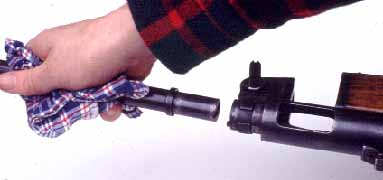
If the jacket and barrel are hot after shooting it is advisable to protect the hand. A thin handkerchief is insufficient for this purpose after a discharge of twenty shots on automatic. A bullet of faulty cartridge stuck in the bore was the usual reason for barrel replacement during battle. According to the booklet "SUOMI-KONEPISTOOLI", published in 1942 by O/Y TIKKAKOSKI AB, it was allowed and safe to remove a stuck bullet by shooting with a full-powered cartridge. This harsh method was, of course, "for extreme urgency only". The primer of cartridge usually exploded during shooting away the stuck bullet, and the extractor disappeared after "duplex ball" shot, but the KP/-31 works well with no extractor at all. The thick-walled barrel easily withstood this misuse but it was necessary to remove the magazine and push the cartridge manually into the chamber.
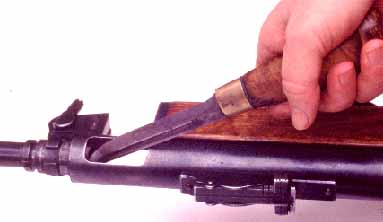 In combat it was not
unusual to shoot barrel and even the jacket of KP/-31 literally red-hot. If cleaning-rod
was not at hand it was possible to turn the jacket loose with the edge of a puukko-knife
and knock the barrel out with the point of puukko. Every Finnish fighter had (and still
has) a knife with sheath as a multi-purpose tool, always hanging on his or her belt.
In combat it was not
unusual to shoot barrel and even the jacket of KP/-31 literally red-hot. If cleaning-rod
was not at hand it was possible to turn the jacket loose with the edge of a puukko-knife
and knock the barrel out with the point of puukko. Every Finnish fighter had (and still
has) a knife with sheath as a multi-purpose tool, always hanging on his or her belt.
Bolt Chiming Like a Bell
The breech-bolt of the KP/-31 is as well made to be everlasting, as is the receiver of the
gun. It is also machined from the best Swedish chromium-nickel steel available in
Thirties and Forties, hardened to 55 Rockwell Cone Hardness, and ground between apices
(centers) of grinding machine. The firing pin is fixed but removable for replacement if
broken. (Point breaks are very rare accidents, despite of length and sharpness of the
firing pin point, necessity for reliable ignition of war-time priming caps). The firing
pin of "pre-Suomi" guns was somewhat similar to that of the Thompson submachine
gun, with a separate actuating lever and firing pin returning spring. In late 1920s Aimo
J. Lahti found this construction overly complicated and unnecessary.
The only Achillean heel of the bolt was the extractor hook which was made of spring steel
but, like most well-designed automatic firearms with blowback action, the KP/-31 is able
to eject spent cases without any extractor at all. It was just advisable to keep the gun
on its right side, ejection port downwards, but this "mowing-fire hold" was
natural to experienced gunners.
Firing Cycle
Preparations for shooting are as follows: Pull the cocking knob all the way rearwards
until the breech-bolt remains in the rear position. The firing mode selector must be
pushed to the frontmost (Full Auto) or intermediate (Semi-Auto) position. The selector's
rearmost position (Safe) prevents movement of sear, and firing and cocking of the KP/-31.
It is usually possible to push box magazines into the magazine-well of an uncocked
submachine gun, keeping the fire selector in "Safe" position until shooting. All
box magazine types may be attached by pushing in, upwards until an audible snap is heard.
Drum magazines are, however, only mounted into a cocked gun. The pull of the trigger lets
the breech-bolt to move forwards. The stroke length from triggering to discharge is 70
millimeters (2.76 in.). The recoil-spring actuated breech-bolt gains "momentum"
for slightly more than half of this distance. Then it picks a cartridge from magazine and
thrusts it into chamber.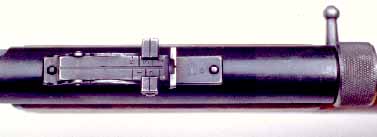
Top view of the receiver. The rear sight is graduated to 500 meters for harassment firing. Aimed shots could hit enemy individuals within 300 meters, but within distances of less than a hundred meters - common in skirmishes in afforrested terrain - the shooter simply pointed the gun in the direction of the enemy without aiming. Most skilled submachine gunners could operate their KP/-31 like a long-range shotgun, without the need of sights. A high rate of full-automatic fire had its uses.
"Differential Locking System"
The firing pin point, protruding 1.20 to 1.25 millimeters from the face of the flat
bolt-recess bottom, dents the bottom of the primer and discharges cartridge, while the
breech-bolt is still going forwards. The MOMENTUM of the bolt (MASS multiplied by
VELOCITY) keeps the cartridge case immobile in chamber, until the peak pressure of the
powder gases has lowered to ten per cent level from 2600 atmospheres (the allowable
maximum chamber pressure of the 9 x 19 mm Luger cartridge). During the pressure peak the
breech-bolt is still moving forwards, accomplishing the so called "differential
locking" by combined weight and velocity, momentum.
When the movement of the bolt has stopped, the walls of the cartridge-case stick into the
walls of the chamber, slowing down or temporarily stopping backwards movement of the bolt.
During this time the bullet comes out from the muzzle. Gas pressure in the bore and
chamber falls down rapidly. The elasticity of metal loosens cartridge-case from the
chamber walls. The remaining gas pressure blows the case backwards like a piston of an
internal combustion engine.
The spent case pushes the breech-bolt back against the power of the recoil spring and the
inertia of bolt weight. The mass of the bolt gains velocity (again the momentum) which
hurls the bolt back the whole cyclic stroke length of 82 millimeters, until the rear-end
of the bolt meets the diaphragm of the receiver end-cap. Firing now continues until the
last cartridge is spent, if the fire selector is pushed to the frontmost "Full
Auto" position. Release of the trigger stops the shooting. An expert submachine
gunner can shoot bursts of two or three shots despite the rather high cyclic rate of fire
- 750 to 800 rounds per minute with usual 9 mm pistol loads and up to 1000 r.p.m. with
Finnish, German or Canadian special 9 mm submachine gun loads.
Cartridges which are too weak may also develop a high cyclic rate, along with
uncontrollable fire: The release of trigger will not stop firing and the gun shoots a long
burst until the magazine is empty, even when fire selector is in "Semi-Auto"
position! If the gunner is inexperienced the consequences of uncontrollable fire become
fatal to bystanders! If the pressure of powder gas and/or the momentum of retreating
breech-bolt is insufficient to thrust the bolt backwards no more than ca. 60 to 69
millimeters the retreat of bolt too short. Then the sear cannot catch the bolt but the
bolt is by now able to eject the spent case and pick the next cartridge from the magazine,
thrust it into chamber and discharge it. This phenomenon, known as a "short
stroke", is well-known to designers of special handloads (especially subsonics), but
some weakened wartime surplus cartridges may also develop short strokes.
Submachine Gun as a Small-Game Rifle
The trigger mechanism has no positive disconnector, like as that of the STEN or Bergmann MP 28-II, but if the original or spare bolt is fitted with
skill and knowledge it is possible to shoot single shots with the KP/-31, one per a pull
of the trigger at a rate of twenty to thirty aimed shots per minute - depends on
the skill and experience of the gunner. During the Third Finnish Independence War (or the
Russian Great Patriotic War - your choice) the KP/-31 was used as a hunting rifle in order
to acquire some more meat in the form of forest birds and squirrels, thus making the
diluted war-time soup more nutritive. An experienced hunter could easily hit the head of a
squirrel from fifty meters if the sights of his Suomi-gun were adjusted "for his
eye" and the barrel jacket was tightened to the receiver with one or two 0.10
millimeter thick steel washers.
These "accuracy jobs", hunting small-game animals or enemy officers, were the
only instances when KP/-31 was used like a self-loading rifle, the shooter keeping the
gun's buttstock firmly against his shoulder and making use of the sights for aiming.
Full-automatic fire was usually just directed by instinct because smoke of pistol powder
obscured the view ahead of the muzzle after the first or second shot of the burst. The
vast majority of handgun powders contain potassium nitrate or other inorganic salts, being
in fact just "semi-smokeless" propellants.
A Doctrine of Escalation
Semi-automatic shooting was the recommendation during the Thirties. The doctrine was to
use the KP/-31 as a self-loading carbine and save the option of burst-fire for urgency
only. The Winter War experience taught the submachine gunners to shoot bursts of two to
three rounds and during the 1941 - 1944 war it was known that no fewer than five or six 9
mm bullets were a sufficient dose of medicine. Wounded with shorter bursts, enemy soldiers
could often continue fighting when they recovered from the initial shock even if the hits
would prove fatal after a short while.
The Finnish proverb "Siberia shall teach" was true also in the form:
"Siberians shall teach". Many "Russian" invaders in the Winter War of
1939 - 1940 were actually conscripts from Ukraine and other south-western republics of
Soviet Union. Many Russian soldiers of the north-western front in the 1941 - 44 war
against Finland were tough and persistent natives of the Siberian wilds and forests. Some
Finns knew them from the earlier war.
"They were formidable opponents. We were urged to kill almost every Siberian twice,
and most tough boys still a third time", told many Finnish veterans of wars:
"Russian lads, coming against us in closed formation, intoxicated with vodka and
singing Le Internationale, were bunny-boys but the Siberians were born soldiers! We met
them in February 1940 and we learnt to respect those slant-eyed imps... !" Two
bullets were enough for "bunny-boys" but five hits were necessary to dispatch a
Siberian "imp". Sometimes they fought back despite ten or twelve wounds from 9
mm bullets.
Continued: To Part 2/2 >>
Link Page Gunwriters To Part 2/2 of Suomi History
Gunwriters on the Web Suomi SMG History part 1 website URL: http://guns.connect.fi/gow/suomi1.html